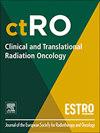First-in-human e-Flash radiotherapy using a modified conventional C-arm linear accelerator
IF 2.7
3区 医学
Q3 ONCOLOGY
引用次数: 0
Abstract
Background
The FLASH effect is considered being the widening of the therapeutic window at (ultra-)high dose rates due to sparing of normal tissues while preserving tumor response. Our goal was to provide first data on the safety in treating a patient using a conventional linear accelerator converted to deliver 9 MeV UHDR electron beams in the research setting.
Material & methods
A conventional Varian TrueBeam linac was converted in the research setting to become capable of delivering 9 MeV UHDR electron beams. A phase I trial protocol was approved by the local authorities (NCT06549439). One patient with ≥ 1 melanoma (sub)-cutaneous lesion(s) was treated with 3x 9 Gy. The first two fractions were applied via e-Flash and the third via conventional electrons.
Results
Here we present the experience of the first patient treated with e-Flash in a modified conventional linac. The e-Flash fractions were successfully delivered according to the protocol. The film in-vivo dosimetry confirmed correctness of the delivered dose. A good tumor response without severe or unexpected toxicity was observed up to six weeks after treatment.
Conclusion
We demonstrate first-in-human application of e-Flash delivered by a modified conventional linear accelerator. Conversion of conventional linacs into e-Flash systems will accelerate testing Flash radiotherapy in clinical trials.
首次使用改良的传统c臂直线加速器进行人体e-Flash放射治疗
FLASH效应被认为是在(超高)高剂量率下,由于在保留肿瘤反应的同时保留了正常组织,从而扩大了治疗窗口。我们的目标是提供关于在研究环境中使用传统线性加速器转换为提供9 MeV UHDR电子束治疗患者的安全性的第一批数据。材料和方法在研究环境中,将传统的瓦里安TrueBeam直线加速器转换为能够提供9 MeV的UHDR电子束。I期试验方案已获得当地政府批准(NCT06549439)。1例≥1个黑色素瘤(皮下)病变患者接受3x - 9gy治疗。前两部分通过e-Flash应用,第三部分通过常规电子应用。结果在此,我们介绍了在改良的传统直线机中使用e-Flash治疗的第一位患者的经验。e-Flash组分按照实验方案成功交付。薄膜体内剂量测定证实了给药剂量的正确性。治疗后6周观察到良好的肿瘤反应,没有严重或意想不到的毒性。结论我们首次在人体中应用了改良的传统直线加速器产生的e-Flash。将传统直线加速器转换为e-Flash系统将加速Flash放射治疗在临床试验中的测试。
本文章由计算机程序翻译,如有差异,请以英文原文为准。
求助全文
约1分钟内获得全文
求助全文
来源期刊

Clinical and Translational Radiation Oncology
Medicine-Radiology, Nuclear Medicine and Imaging
CiteScore
5.30
自引率
3.20%
发文量
114
审稿时长
40 days
 求助内容:
求助内容: 应助结果提醒方式:
应助结果提醒方式:


